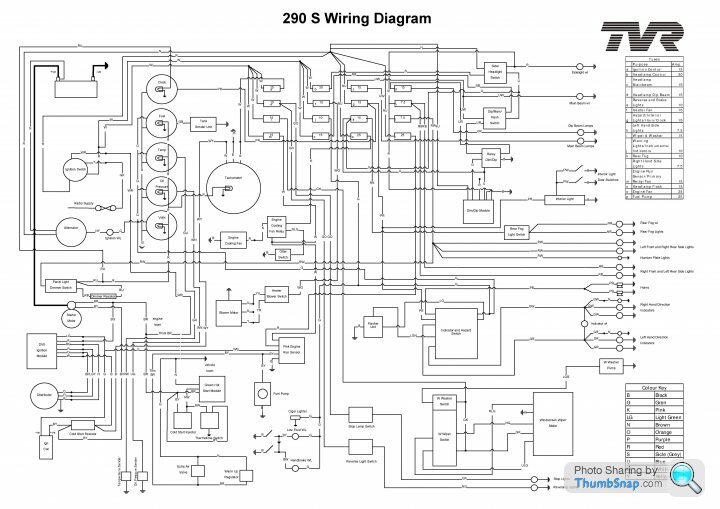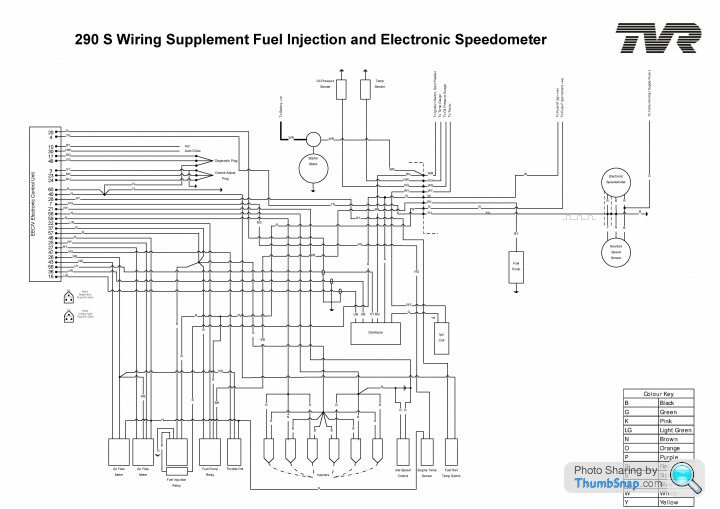S V6 Won't Fire, No Spark
Discussion
Hi folks,
Quick question and I'm probably being an idiot; does anybody know the wiring arrangement for the coil? Had her running a month or so back, but had to replace the exhaust manifold. Since it's been done, she won't fire. Turns over fine, but no sign of a spark.
Inspected the coil, which has seen better days and ordered a replacement. New one has turned up and been fitted but still won't fire.
Wiring diagram shows YB to +ve and green off - ve, which is what I've done. I also have a extra red wire, which I assume is for the immobiliser (?).
Still won't fire; voltmeter shows nothing across any of the connections of the battery...
All very weird. Any suggestions? I'm starting to think the coil wasn't the culprit....
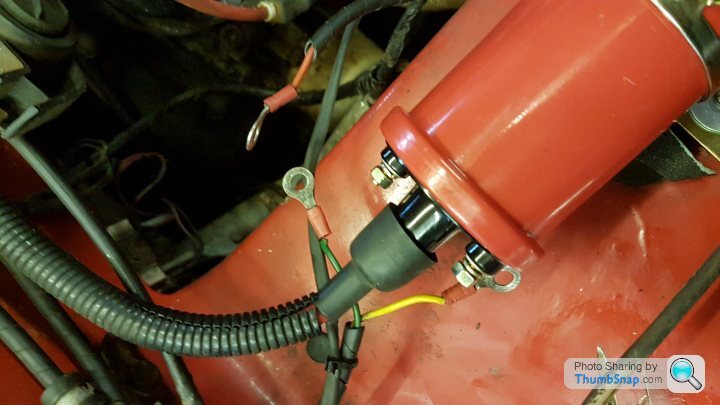
Quick question and I'm probably being an idiot; does anybody know the wiring arrangement for the coil? Had her running a month or so back, but had to replace the exhaust manifold. Since it's been done, she won't fire. Turns over fine, but no sign of a spark.
Inspected the coil, which has seen better days and ordered a replacement. New one has turned up and been fitted but still won't fire.
Wiring diagram shows YB to +ve and green off - ve, which is what I've done. I also have a extra red wire, which I assume is for the immobiliser (?).
Still won't fire; voltmeter shows nothing across any of the connections of the battery...
All very weird. Any suggestions? I'm starting to think the coil wasn't the culprit....

Can you clarify "voltmeter shows nothing across any of the connections of the battery...".
Also try a separate earth from the mounting bracket to the chassis. Yes, I know this isn't supposed to be necessary but when I had a similar problem that was the solution. It'll only take you a minute to find out whether or not this is the problem.
Also try a separate earth from the mounting bracket to the chassis. Yes, I know this isn't supposed to be necessary but when I had a similar problem that was the solution. It'll only take you a minute to find out whether or not this is the problem.
Edited by v8s4me on Saturday 7th January 17:44
The coil has two terminals that should be marked +ve and -ve.
The +ve terminal should have a nominal 12V supplied to it while the ignition is on. If it doesn't, suspect the fuse, immobiliser or wiring fault. Until you have 12V here, nothing else is going to work.
I don't know whether you have a ballasted coil on your car. If you do, then you will have two wires connecting to coil +ve: one from the ignition switch via a ballast resistor, and one direct from the start solenoid. The ballast resistor drops the coil supply voltage to around 6V while the coil -ve side is earthed. The direct supply bypasses the ballast resistor and feeds battery voltage directly to the coil while the engine is cranking - which will typically mean the coil actually sees around 9V since the starter motor will pull the battery voltage down several volts.
If the +ve side checks out OK then investigate the -ve wiring. It's been a few decades since I looked at that wiring but I seem to remember you'll have two wires: one to the ignition module, and one to the ECU. At the ignition module you'll have a condenser, which is primarily there to buffer the current through the coil low voltage coil but also completes the circuit for the high tension coil; if the condenser has failed than you won't get a spark at all.
Caveat: I've worked on a car where the HT circuit was not grounded via the coil -ve terminal and was grounded via the case instead. I think this is unusual and I'd expect to find both circuits through the coil connected to the coil -ve terminal, but coils do exist that are grounded via the case, and if you've managed to find one then you will need to ground the case for it to work.
The +ve terminal should have a nominal 12V supplied to it while the ignition is on. If it doesn't, suspect the fuse, immobiliser or wiring fault. Until you have 12V here, nothing else is going to work.
I don't know whether you have a ballasted coil on your car. If you do, then you will have two wires connecting to coil +ve: one from the ignition switch via a ballast resistor, and one direct from the start solenoid. The ballast resistor drops the coil supply voltage to around 6V while the coil -ve side is earthed. The direct supply bypasses the ballast resistor and feeds battery voltage directly to the coil while the engine is cranking - which will typically mean the coil actually sees around 9V since the starter motor will pull the battery voltage down several volts.
If the +ve side checks out OK then investigate the -ve wiring. It's been a few decades since I looked at that wiring but I seem to remember you'll have two wires: one to the ignition module, and one to the ECU. At the ignition module you'll have a condenser, which is primarily there to buffer the current through the coil low voltage coil but also completes the circuit for the high tension coil; if the condenser has failed than you won't get a spark at all.
Caveat: I've worked on a car where the HT circuit was not grounded via the coil -ve terminal and was grounded via the case instead. I think this is unusual and I'd expect to find both circuits through the coil connected to the coil -ve terminal, but coils do exist that are grounded via the case, and if you've managed to find one then you will need to ground the case for it to work.
If it worked before you did the manifold (which side?) chances are you've disturbed something, an electrical connection somewhere?
Is the multi-plug thing on the distributor pushed right in?
Do you know where the mystery red wire went before you took things apart, if so put it back, whatever it does it must have worked.
If yours is a 2.9EFI you'll not have a ballast resistor.
Ignition coil does not need an earth, Low tension side earths through the ignition module (points in the olden days) and High Tension earths through the spark plugs.
This subject has come up before, to prove the point I've had my engine running with the coil lying on a wad of rag, definitely not earthed!
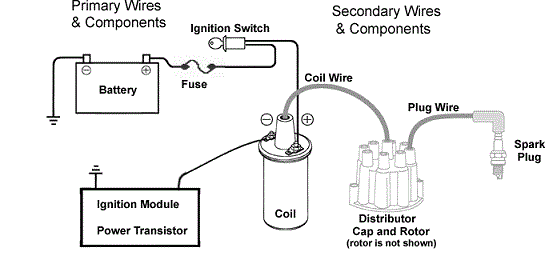
PS , connection looks iffy.......
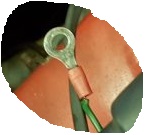
Is the multi-plug thing on the distributor pushed right in?
Do you know where the mystery red wire went before you took things apart, if so put it back, whatever it does it must have worked.
If yours is a 2.9EFI you'll not have a ballast resistor.
Ignition coil does not need an earth, Low tension side earths through the ignition module (points in the olden days) and High Tension earths through the spark plugs.
This subject has come up before, to prove the point I've had my engine running with the coil lying on a wad of rag, definitely not earthed!

PS , connection looks iffy.......


GreenV8S said:
That's slightly misleading. The plugs form part of the circuit through the HT side of the coil - the circuit is completed via the coil -ve terminal via the condenser to ground.
Methinks, he said that ...phillpot said:
... Low tension side earths through the ignition module (points in the olden days) ...
You need to by systematic, don't jump about guessing and replacing things.
When you say "no spark" how exactly have you tested that?
And what is the voltage at the coil +ve with ignition on? Is the coil getting a supply? If not, then are any other ignition- controlled systems working (wipers, indicators)? If not, check the ignition switch, or the famous yellow connector at the steering column - it's not uncommon for the ignition live connector to burn out.
Where does the red wire go? Is it "live" or "earthed" with the immobiliser on or off?
Oh, just on the off-chance, you haven't had the distributor out, have you?
There are other tests to do, depending on the results of those first checks, but you can't cover every possible permutation in a single post!
v8s4me said:
Can you clarify "voltmeter shows nothing across any of the connections of the battery...".
This is the fundamental question. What is the battery voltage?When you say "no spark" how exactly have you tested that?
And what is the voltage at the coil +ve with ignition on? Is the coil getting a supply? If not, then are any other ignition- controlled systems working (wipers, indicators)? If not, check the ignition switch, or the famous yellow connector at the steering column - it's not uncommon for the ignition live connector to burn out.
Where does the red wire go? Is it "live" or "earthed" with the immobiliser on or off?
Oh, just on the off-chance, you haven't had the distributor out, have you?
There are other tests to do, depending on the results of those first checks, but you can't cover every possible permutation in a single post!
Edited by tvrgit on Saturday 7th January 22:25
TVRees said:
GreenV8S said:
That's slightly misleading. The plugs form part of the circuit through the HT side of the coil - the circuit is completed via the coil -ve terminal via the condenser to ground.
Methinks, he said that ...phillpot said:
... Low tension side earths through the ignition module (points in the olden days) ...
The Beaver King said:
Hi folks,
Quick question and I'm probably being an idiot; does anybody know the wiring arrangement for the coil? Had her running a month or so back, but had to replace the exhaust manifold. Since it's been done, she won't fire. Turns over fine, but no sign of a spark.
Inspected the coil, which has seen better days and ordered a replacement. New one has turned up and been fitted but still won't fire.
Wiring diagram shows YB to +ve and green off - ve, which is what I've done. I also have a extra red wire, which I assume is for the immobiliser (?).
Still won't fire; voltmeter shows nothing across any of the connections of the battery...
All very weird. Any suggestions? I'm starting to think the coil wasn't the culprit....

Ive got a pdf of the wiring diag if you need one, the only red should be switched 12v to the fuel pump so it looks like an addition. Disconnecting the tacho will also stop it firing. I have a spare module for the dizzy if your in need. The connectors on these are poor unless you have the gold flashed ones, Quick question and I'm probably being an idiot; does anybody know the wiring arrangement for the coil? Had her running a month or so back, but had to replace the exhaust manifold. Since it's been done, she won't fire. Turns over fine, but no sign of a spark.
Inspected the coil, which has seen better days and ordered a replacement. New one has turned up and been fitted but still won't fire.
Wiring diagram shows YB to +ve and green off - ve, which is what I've done. I also have a extra red wire, which I assume is for the immobiliser (?).
Still won't fire; voltmeter shows nothing across any of the connections of the battery...
All very weird. Any suggestions? I'm starting to think the coil wasn't the culprit....

so to test.
Does the fuel pump run for 5 secs or so when you turn the ignition on (dont crank the engine) if it does its not your immobiliser ( unless its aftermarket then all bets are off)
Do you see voltage across the coil connections whilst cranking.
Can you hear the injectors firing whilst cranking, you can replicate this test by removing the cap and rotor arm, remove the 2 screws that hold the sensor disc in place, and turn it manually with the ignition on. you should hear the injectors clicking. If not give the dissy connector a dam good clean.
Gents,
Thanks for the comments, will give it another crack on Wednesday.
Just to clarify some bits:
1. I did notice the dodgy looking green connector, will definitely be sorted but doesn't seem to be the issue.
2. By 'no voltage' I mean that it isn't showing any volts on the ammeter, from any of the connections back to the battery. Starting to think a fuse....
3. I picked the coil up off Ebay, didn't look too much into it other than it was for a 2.9 V6 Granada.
As I'm typing this, I've just rechecked the box it was delivered in and found a ballast resistor at the bottom, hidden!!!
That could well be my problem there....
Thanks for the comments, will give it another crack on Wednesday.
Just to clarify some bits:
1. I did notice the dodgy looking green connector, will definitely be sorted but doesn't seem to be the issue.
2. By 'no voltage' I mean that it isn't showing any volts on the ammeter, from any of the connections back to the battery. Starting to think a fuse....
3. I picked the coil up off Ebay, didn't look too much into it other than it was for a 2.9 V6 Granada.
As I'm typing this, I've just rechecked the box it was delivered in and found a ballast resistor at the bottom, hidden!!!
That could well be my problem there....
The Beaver King said:
2. By 'no voltage' I mean that it isn't showing any volts on the ammeter, from any of the connections back to the battery. Starting to think a fuse....
Umm, ammeters show amps not volts?The Beaver King said:
As I'm typing this, I've just rechecked the box it was delivered in and found a ballast resistor at the bottom, hidden!!!
That could well be my problem there....
Err, doubt it, as A. you had the problem before replacing the coil and B. ballast coil will work with 12 volts (may not last too long but it will work).That could well be my problem there....
Had a problem with the ballast resistor on my Taimar once, by-passed it and drove 30 miles home with full 12 volts going into the coil
Penelope Stopit said:
I hope this will help
Not a lot if his car is a 2.9, he'll need this bit..................EFi wiring diagram
ETA nicely edited Penny

Edited by phillpot on Sunday 8th January 17:32
Let's try again...
tvrgit said:
You need to by systematic, don't jump about guessing and replacing things.
When you say "no spark" how exactly have you tested that?
And what is the voltage at the coil +ve with ignition on? Is the coil getting a supply__? If not, then __are any other ignition- controlled systems working (wipers, indicators)? If not, check the ignition switch, or the famous yellow connector at the steering column - it's not uncommon for the ignition live connector to burn out.
Where does the red wire go? Is it "live" or "earthed" with the immobiliser on or off?
Oh, just on the off-chance, you haven't had the distributor out, have you?
There are other tests to do, depending on the results of those first checks, but you can't cover every possible permutation in a single post!
v8s4me said:
Can you clarify "voltmeter shows nothing across any of the connections of the battery...".
This is the fundamental question. What is the battery voltage? (volts, not amps)When you say "no spark" how exactly have you tested that?
And what is the voltage at the coil +ve with ignition on? Is the coil getting a supply__? If not, then __are any other ignition- controlled systems working (wipers, indicators)? If not, check the ignition switch, or the famous yellow connector at the steering column - it's not uncommon for the ignition live connector to burn out.
Where does the red wire go? Is it "live" or "earthed" with the immobiliser on or off?
Oh, just on the off-chance, you haven't had the distributor out, have you?
There are other tests to do, depending on the results of those first checks, but you can't cover every possible permutation in a single post!
GreenV8S
I find it very amusing that you mention phillpot's post is misleading when you have posted a load of nonesense here
This is an electronic ignition system No Condenser. If it was a mechanical points system the HT Voltage does not earth through the condenser and I am not going to start explaining to you what the condenser is for in a points system
You also mention At the ignition module you'll have a condenser, which is primarily there to buffer the current through the coil low voltage coil but also completes the circuit for the high tension coil; if the condenser has failed than you won't get a spark at all. This is not the case, the only condenser you may have seen wired to a ignition module is very likely a condenser that has been fitted in an attempt to cure radio interference
There was nothing misleading aboutphillpot's post
Note, the coil does not require to be grounded, depending where the coil is fitted, grounding the coil will help in cooling it
You must be joking, I am pissing myself laughing
I find it very amusing that you mention phillpot's post is misleading when you have posted a load of nonesense here
This is an electronic ignition system No Condenser. If it was a mechanical points system the HT Voltage does not earth through the condenser and I am not going to start explaining to you what the condenser is for in a points system
You also mention At the ignition module you'll have a condenser, which is primarily there to buffer the current through the coil low voltage coil but also completes the circuit for the high tension coil; if the condenser has failed than you won't get a spark at all. This is not the case, the only condenser you may have seen wired to a ignition module is very likely a condenser that has been fitted in an attempt to cure radio interference
There was nothing misleading aboutphillpot's post
Note, the coil does not require to be grounded, depending where the coil is fitted, grounding the coil will help in cooling it
You must be joking, I am pissing myself laughing
Edited by Penelope Stopit on Sunday 8th January 17:28
Edited by Penelope Stopit on Sunday 8th January 17:29
Edited by Penelope Stopit on Sunday 8th January 17:48
phillpot said:
Penelope Stopit said:
I hope this will help
Not a lot if his car is a 2.9, he'll need this bit..................EFi wiring diagram
ETA nicely edited Penny

Edited by phillpot on Sunday 8th January 17:32
I think we're getting distracted here by talk of condensers and stuff, that don't have any bearing on the OPs problem.
There are two possible condensers in a "conventional" ignition system.
1. A condenser across the ignition points, inside the distributor. As far as I was taught, the ignition circuit will still work whether that condenser is there or not - it's the making and breaking of the points that builds and collapses the magnetic flux in the primary windings, that creates the spark from the secondary winding. What that condenser does, is reduce LT sparking across the Points, reducing erosion and prolonging the life of the ignition points. Modern electronic ignition systems, such as that used in the S, gave no points and no condenser in the distributor. So while interesting, nothing to do with the OP's problem.
2. A condenser between the coil LT +ve terminal and earth. These are usually fitted as radio interference suppressors. That's all they do - they don't make the engine run better, or anything. My S had a radio suppressor on the coil when I got it, but the terminal fell off the wire so I chucked it. Don't know if it makes any difference because I never listen to the radio anyway.
Meanwhile, back to the OP's "no start" problem...
There are two possible condensers in a "conventional" ignition system.
1. A condenser across the ignition points, inside the distributor. As far as I was taught, the ignition circuit will still work whether that condenser is there or not - it's the making and breaking of the points that builds and collapses the magnetic flux in the primary windings, that creates the spark from the secondary winding. What that condenser does, is reduce LT sparking across the Points, reducing erosion and prolonging the life of the ignition points. Modern electronic ignition systems, such as that used in the S, gave no points and no condenser in the distributor. So while interesting, nothing to do with the OP's problem.
2. A condenser between the coil LT +ve terminal and earth. These are usually fitted as radio interference suppressors. That's all they do - they don't make the engine run better, or anything. My S had a radio suppressor on the coil when I got it, but the terminal fell off the wire so I chucked it. Don't know if it makes any difference because I never listen to the radio anyway.
Meanwhile, back to the OP's "no start" problem...
Edited by tvrgit on Sunday 8th January 18:30
Gassing Station | S Series | Top of Page | What's New | My Stuff




